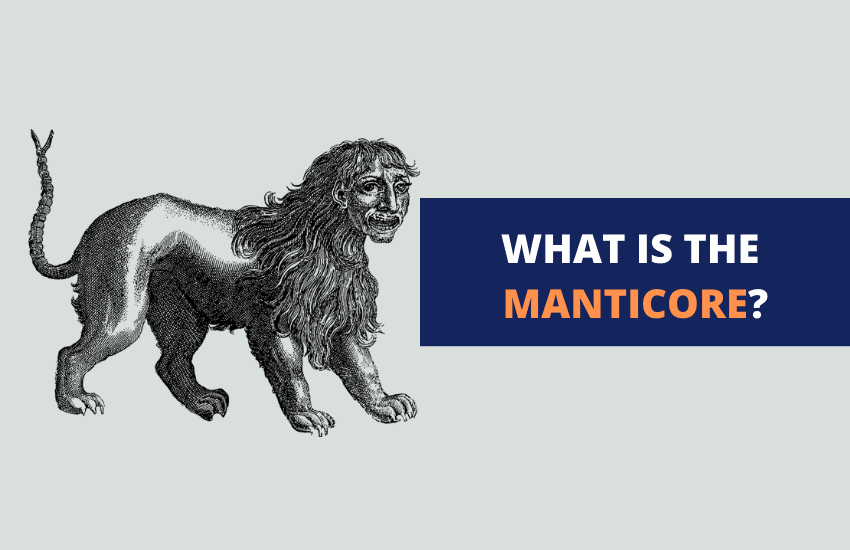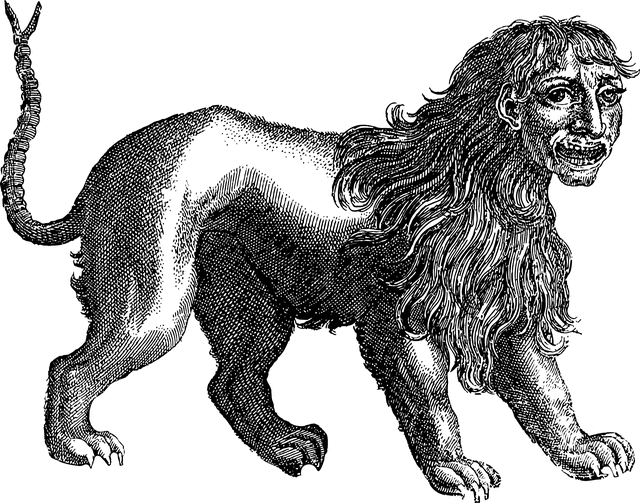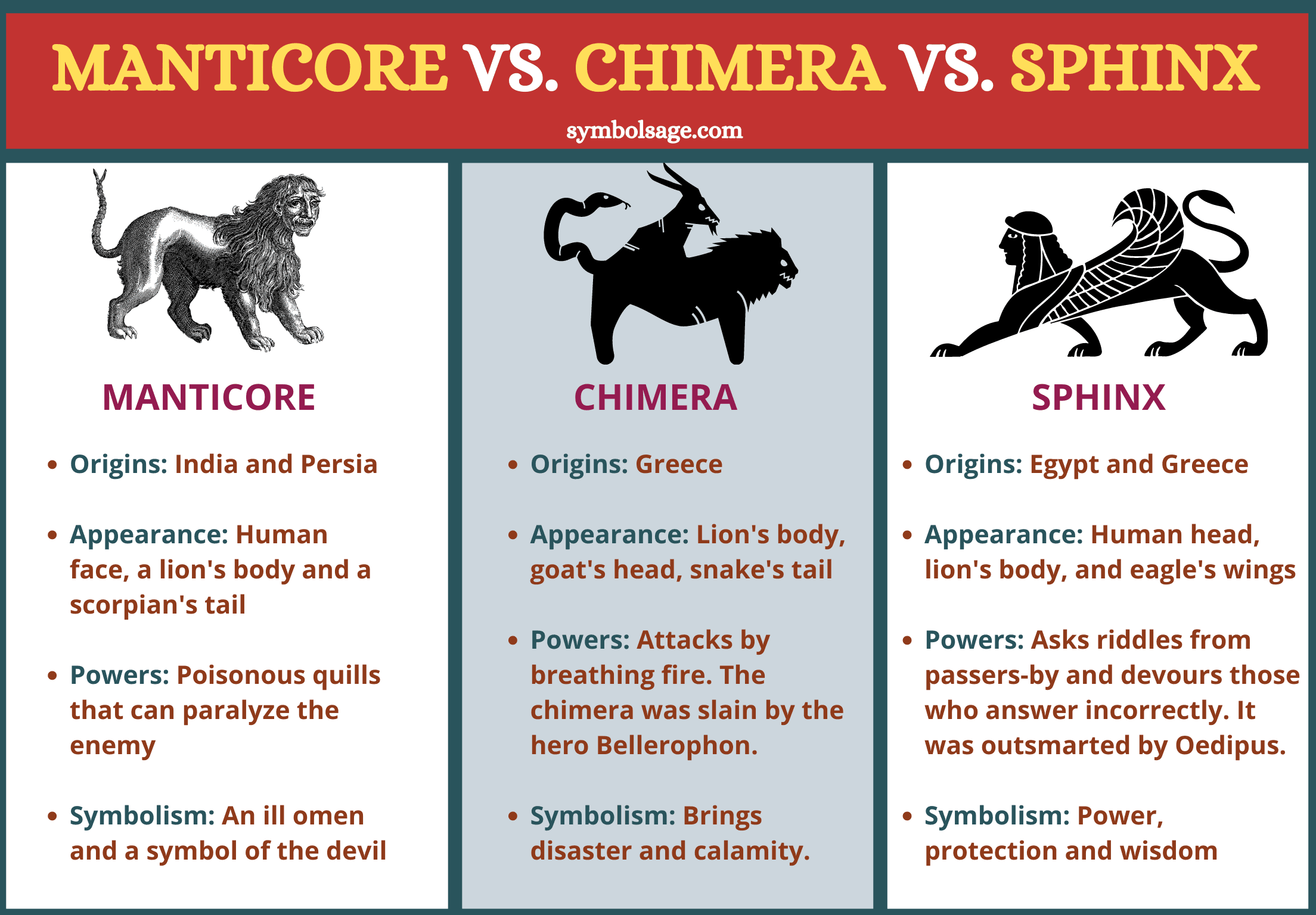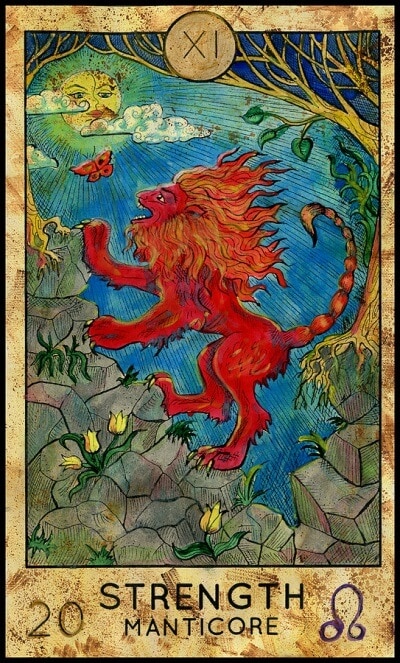
Table of Contents
The Manticore is a mythological beast with a human face and a lion’s body, described as a malevolent creature with unmatched skills and abilities. The name manticore comes from a Persian word martichora, whichmeans Man-Eater.
The manticore is often confused for the Greek chimera or the Egyptian sphinx but it’s a very different creature. The origins of the Manticore can be traced back to Persia and India, but its meaning and significance has traversed across cultures. The Manticore has attained universal fame and has become a popular motif in literary texts, artworks, and popular culture.
In this article we will be exploring the origins and symbolism of the Manticore, and the difference between the Manticore, Sphinx and Chimera.
Origins and History of the Manticore
The origins of the Manticore can be traced back to Persia and India. The Europeans first discovered the Manticore in Persia, but the general consensus is that the myth was transported to Persia from India. Therefore, the original birthplace of the Manticore is the forests and jungles of India. From here, the Manticore had widespread influence.
- Ancient Greece
The first written record of the Manticore can be traced back to the Greeks. Ctesias, a Greek physician, wrote about the Manticore in his book Indica. Ctesias’ record was based on his observation of the creature in the court of Artaxerxes II, a Persian king. The Persians, however, insisted the Manticore was not endemic to their culture, and had come from the jungles of India.
Ctesias’ observations on the Manticore were both endorsed and denied by Greek writers and scholars. For instance, Pausanias, a famed Greek writer, refuted Ctesias views by declaring that he mistook a tiger for a Manticore. The Manticore became a focal point of discussion after the publication of Naturalis Historia by Pliny the Elder.
- Europe
Once the Manticore entered the western world, its meaning and significance drastically changed. Amongst the Persians and Indians, the Manticore was revered and feared for its impressive demeanor. Among the Christian believers, however, the Manticore became a symbol of the devil that represented evil, envy, and tyranny. Even as late as the 1930’s, the Manticore was associated with negative connotations, and the Spanish Christian peasants looked upon it as an ill omen.
- South East Asia/India
In some parts of South East Asia and India, the local folk believe that a creature akin to the Manticore can be found in the jungles. There’s no concrete proof to say whether people really believe in Manticores, or if it is merely a pretense to prevent wandering travelers from traversing the forests. Some scholars say that the Eastern Manticore is none other than the Bengali tiger.
Characteristics of the Manticore

The Manticore has a face that resembles a bearded man and the body of a lion. It has tail of a scorpion, covered with sharp quills. The Manticore is covered in red fur, has rows of sharp, pointed teeth, and grey or green eyes.
Abilities:
- The Manticore has a charming and melodious voice that sounds like a flute and trumpet. Animals and humans flee from this voice because it serves as a warning that a Manticore is nearby.
- Manticores have tails studded with sharp quills which they can shoot off to great distances. The tail can be stretched forward or backwards, depending on the range of the attack.
- Manticores can leap quickly and cover large distances in a short period of time.
Limitations:
- Manticores limitation appears to be an inability to kill elephants for some unknown reason. Why this was considered an important point isn’t known.
- Baby Manticores cannot grow quills if their tail is crushed, and therefore they cannot sting or poison an enemy.
Symbolic Meanings of Manticores
The Manticore is predominantly seen as a symbol of evil in many cultures across the world. However, it also has many other significations and symbolic meanings in various religions and cultures. Some of the prominent ones will be explored below.
- Symbol of evil tidings: The Manticore is thought to be a symbol of evil tidings and calamities. It is believed to bring bad luck and misfortune to those who see it. In this respect, the Manticore has a similar meaning to the black cat, which is seen as an ill omen in today’s society.
- Symbol of Asian culture: According to the ancient Greeks, the Manticore symbolized the mysterious lands of Asia. Akin to the Manticore, Asia was thought to be a strange, mystical, and unknown continent.
- Symbol of strength: The Manticore symbolizes undefeatable strength and power. It is believed that a Manticore could effortlessly eat the flesh and bones of several human beings. The Manticore is used as an emblem in heraldry, to reflect a soldier’s strength and power.
- Symbol of tyrants: Many Europeans considered the Manticore to be a symbol of ruthless tyrants, who were merciless and cruel to the peasant folk.
- Symbol of Jeremiah: In 16th century Christian beliefs, the Manticore came to be an emblem of prophet Jeremiah. Both the Manticore and the prophet were believed to live and thrive underground.
Manticore vs. Chimera vs. Sphinx

The Manticore, Chimera, and Sphinx are often confused due to their similarity in appearance. Although all three resemble each other in some way, they have different skills and abilities. Some of the differences between the three mythological beings will be explored below.
Origins
- The Manticore can be traced back to Persian and Indian mythology.
- The Chimera is a mythological being of the ancient Greeks, and the offspring of Typhon and Echidna.
- The Sphinx is a mythical being that appears in both Egyptian and Greek mythology.
Appearance
- The Manticore has a human face, a lion’s body, and the tail of a scorpion. It has red fur and blue/grey eyes.
- The Chimera has a lion’s body, the head of a goat, and tail of a snake. Some people claim that it can also have a lion’s head, and the body of a goat.
- The Sphinx has a human head, a lion’s body, wings of an eagle, and tail of a snake. It is thought to be a female, since its’ face resembles a woman.
Symbolic Significance
- The Manticore is an ill omen and a symbol of the devil.
- The Chimera is thought to bring disaster and calamity to those who encounter it.
- The Sphinx is an emblem of power, protection, and wisdom.
Abilities
- The Manticore has a powerful tail embedded with quills. These quills are poisonous and can paralyze the enemy.
- The Chimera can attack by breathing fire.
- The Sphinx is highly intelligent and asks riddles from trespassers. It devours those who fail to answer correctly.
Manticore in Heraldry
In Medieval Europe, Manticore symbols were etched onto shields, helms, armor, and coats of arms. Manticores were engraved onto heraldry to represent the group or classification of a knight. As opposed to other mythological beings, Manticores weren’t a popular symbol for armaments, due to their malevolent attributes. The Manticore symbols that appeared in Heraldry usually had additional characteristics such as large horns, and feet, that resembled a dragon or monkey.
Manticores in Popular Culture

The Manticore is a popular motif in books, movies, artworks, and videogames. The mythological creature has been a fascination for creative individuals, who have incorporated it into their diverse works.
Books:
- The Manticore first appeared in Indica, a book written by Ctesias, a Greek physician in the fourth century BC.
- The Manticore has been included in Medieval bestiaries such as The History of Four-Footed Beasts and Serpents by Edward Topsell.
- The Manticore appears in The Unicorn, the Gorgon and the Manticore, a Madrigalfableauthored by Gian Carlo Menotti. In this fable, the Manticore takes on the appearance of a moderately shy creature.
- The Manticore can be witnessed in popular fiction such as Salman Rushdie’s The Satanic Verses, and J.K. Rowling’s Harry Potter series.
Movies:
- A science fiction movie Manticore was released in 2005.
- The Manticore was an important character in one of the earlier scripts of Avatar, a movie directed by James Cameron.
- The Manticore is featured in an animated movie, The Last Unicorn as well as in the Disney movie Onward. In Onward, the Manticore is a lovable female figure who discovers her fearlessness.
Video games:
Manticores are very popular characters in video games and computer games.
- In The legend of the Dragon they appear as enemies.
- In the game Heroes of Might and Magic V, they appear as a creature neither with positive nor negative attributes.
- In Titan Quest the Manticore appears as a legendary mythological creature.
Artworks:
- The Manticore has influenced mannerist paintings such as The Exposure of Luxury which by Agnolo Bronzino.
- It’s appeared in several grotesque paintings from the 18th century onwards.
To Wrap It Up
The Manticore is one of most ancient mythological creatures, that has gained universal fame and popularity. The negative connotations associated with the Manticore continue to exist, casting this legendary hybrid creature as a fearsome, evil predator.








